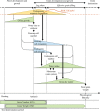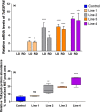Overcoming the trade-off between grain weight and number in wheat by the ectopic expression of expansin in developing seeds leads to increased yield potential
- PMID: 33124693
- PMCID: PMC8048851
- DOI: 10.1111/nph.17048
Overcoming the trade-off between grain weight and number in wheat by the ectopic expression of expansin in developing seeds leads to increased yield potential
Abstract
Wheat is the most widely grown crop globally, providing 20% of all human calories and protein. Achieving step changes in genetic yield potential is crucial to ensure food security, but efforts are thwarted by an apparent trade-off between grain size and number. Expansins are proteins that play important roles in plant growth by enhancing stress relaxation in the cell wall, which constrains cell expansion. Here, we describe how targeted overexpression of an α-expansin in early developing wheat seeds leads to a significant increase in grain size without a negative effect on grain number, resulting in a yield boost under field conditions. The best-performing transgenic line yielded 12.3% higher average grain weight than the control, and this translated to an increase in grain yield of 11.3% in field experiments using an agronomically appropriate plant density. This targeted transgenic approach provides an opportunity to overcome a common bottleneck to yield improvement across many crops.
Keywords: expansin protein; grain number; grain weight; grasses; pericarp; trade-off; transgenic.
© 2020 The Authors. New Phytologist © 2020 New Phytologist Foundation.
Figures







Comment in
-
Expanding wheat yields with expansin.New Phytol. 2021 Apr;230(2):403-405. doi: 10.1111/nph.17245. Epub 2021 Mar 2. New Phytol. 2021. PMID: 33650686 No abstract available.
References
-
- Acreche MM, Slafer GA. 2006. Grain weight response to increases in number of grains in wheat in a Mediterranean area. Field Crops Research 98: 52–59.
-
- Appels R, Eversole K, Feuillet C, Keller B, Rogers J, Stein N, Pozniak CJ, Choulet F, Distelfeld A, Poland J et al. 2018. Shifting the limits in wheat research and breeding using a fully annotated reference genome. Science 361: eaar7191. - PubMed
-
- Bae JM, Kwak MS, Noh SA, Oh MJ, Kim YS, Shin JS. 2014. Overexpression of sweetpotato expansin cDNA (IbEXP1) increases seed yield in Arabidopsis. Transgenic Research 23: 657–667. - PubMed
-
- Borrás L, Slafer GA, Otegui ME. 2004. Seed dry weight response to source–sink manipulations in wheat, maize and soybean: a quantitative reappraisal. Field Crops Research 86: 131–146.
-
- Brinton J, Simmonds J, Minter F, Leverington‐Waite M, Snape J, Uauy C. 2017. Increased pericarp cell length underlies a major quantitative trait locus for grain weight in hexaploid wheat. New Phytologist 215: 1026–1038. - PubMed
Publication types
MeSH terms
Substances
Grants and funding
LinkOut - more resources
Full Text Sources
Other Literature Sources

